Themed collection International Year of the Periodic Table : Single Atoms as Active Catalysts

Engineering ultrasmall metal nanoclusters for photocatalytic and electrocatalytic applications
The many fundamental properties of ultrasmall noble metal nanoclusters have made it increasingly clear that they possess enormous potential for photo- and electro-catalytic applications due to their unique electronic and optical properties.

Nanoscale, 2019,11, 20437-20448
https://doi.org/10.1039/C9NR07272A
Design of atomically dispersed catalytic sites for photocatalytic CO2 reduction
This Minireview highlights recent key developments of atomically dispersed catalytic sites for photocatalytic CO2 reduction and elucidates the common fundamentals behind various materials systems.

Nanoscale, 2019,11, 11064-11070
https://doi.org/10.1039/C9NR03616D
Atomic (single, double, and triple atoms) catalysis: frontiers, opportunities, and challenges
SACs, DACs, and TACs, heterogeneous catalysts with the advantages of homogeneous catalysts, are ideal models for exploring catalytic mechanisms and further designing catalysts.

J. Mater. Chem. A, 2019,7, 3492-3515
https://doi.org/10.1039/C8TA11416A
Recent progress in single-atom electrocatalysts: concept, synthesis, and applications in clean energy conversion
Introduction of recently reported single-atom catalysts and their application in the field of clean energy conversion.

J. Mater. Chem. A, 2018,6, 14025-14042
https://doi.org/10.1039/C8TA04064H
Single-atom catalysts and their applications in organic chemistry
Recent advances in single atom catalysts and their applications in organic chemistry are fully summarized in this review.
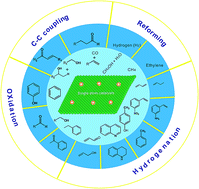
J. Mater. Chem. A, 2018,6, 8793-8814
https://doi.org/10.1039/C8TA01940A
Ultrafine Pt cluster and RuO2 heterojunction anode catalysts designed for ultra-low Pt-loading anion exchange membrane fuel cells
Pt–RuO2 heterojunction catalysts with a unique morphology show excellent alkaline membrane fuel cell performance at an ultra-low loading Pt anode.

Nanoscale Horiz., 2020,5, 316-324
https://doi.org/10.1039/C9NH00533A
Metal-promoted Mo6S8 clusters: a platform for probing ensemble effects on the electrochemical conversion of CO2 and CO to methanol
Presented herein is an investigation of a promising ternary metal sulfide catalyst that is capable of electrochemically converting CO2 to liquid and gas fuels such as methanol and hydrogen.

Mater. Horiz., 2020,7, 193-202
https://doi.org/10.1039/C9MH00745H
Clean rhodium nanoparticles prepared by laser ablation in liquid for high performance electrocatalysis of the hydrogen evolution reaction
Rhodium nanoparticles prepared by a facile laser ablation procedure show excellent activity towards the hydrogen evolution reaction.

Nanoscale Adv., 2019,1, 4296-4300
https://doi.org/10.1039/C9NA00510B
Oxygen-assisted stabilization of single-atom Au during photocatalytic hydrogen evolution
Pre-treatment of graphitic carbon nitride (GCN) with H2O2 introduces active C–OH groups that can react with HAuCl4 to immobilize single atom Au(I) in the GCN matrix through creating robust Au(I)–O coordination bonds.

J. Mater. Chem. A, 2019,7, 24217-24221
https://doi.org/10.1039/C9TA10290F
Synergistic catalysis between atomically dispersed Fe and a pyrrolic-N-C framework for CO2 electroreduction
Atomically dispersed Fe immobilized within N-doped carbon nanosheets was synthesized. The synergistic effect between the metal atom and its anchoring framework sites has been investigated for efficient CO2 reduction.
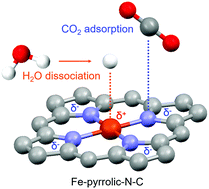
Nanoscale Horiz., 2019,4, 1411-1415
https://doi.org/10.1039/C9NH00361D
Functional mapping reveals mechanistic clusters for OER catalysis across (Cu–Mn–Ta–Co–Sn–Fe)Ox composition and pH space
Analysis and visualization of over 2121 OER catalyst compositions over pH 3–13 identifies mechanistic clusters.

Mater. Horiz., 2019,6, 1251-1258
https://doi.org/10.1039/C8MH01641K
Single-atomic-site cobalt stabilized on nitrogen and phosphorus co-doped carbon for selective oxidation of primary alcohols
Single-atomic-site Co stabilized on nitrogen and phosphorus co-doped carbon exhibits superior performance for the oxidation of substituted primary alcohols.
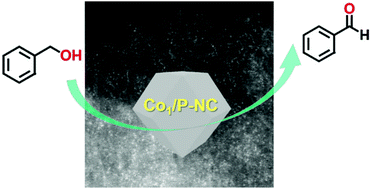
Nanoscale Horiz., 2019,4, 902-906
https://doi.org/10.1039/C9NH00036D
Carbon nanotube-linked hollow carbon nanospheres doped with iron and nitrogen as single-atom catalysts for the oxygen reduction reaction in acidic solutions
A three-dimensional structure consisting of atomically dispersed Fe, N-doped hollow carbon nanospheres linked by carbon nanotubes was engineered as an electrocatalyst showing a high activity for oxygen reduction reaction.

J. Mater. Chem. A, 2019,7, 14478-14482
https://doi.org/10.1039/C9TA00508K
Composition-driven shape evolution to Cu-rich PtCu octahedral alloy nanocrystals as superior bifunctional catalysts for methanol oxidation and oxygen reduction reaction
Cu-Rich PtCu octahedral alloy nanocrystals have been achieved by a composition-driven strategy and used as a robust bifunctional electrocatalyst for MOR and ORR in an acid medium.

Nanoscale, 2018,10, 4670-4674
https://doi.org/10.1039/C7NR09669K
Atomic scale deposition of Pt around Au nanoparticles to achieve much enhanced electrocatalysis of Pt
We achieved atomic scale deposition of Pt around Au nanoparticles and enhanced Pt electrocatalysis for formic acid oxidation.
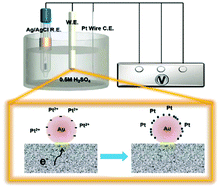
Nanoscale, 2017,9, 7745-7749
https://doi.org/10.1039/C7NR02711G
Interfacial synergy of ultralong jagged Pt85Mo15–S nanowires with abundant active sites on enhanced hydrogen evolution in an alkaline solution
Ultralong jagged PtMo–S nanowires with rich “interfacial active sites” were fabricated by using S as the “active auxiliary” to demonstrate the enhanced catalytic HER performance triggered by the electronic and synergistic effects of PtMo/MoSx.
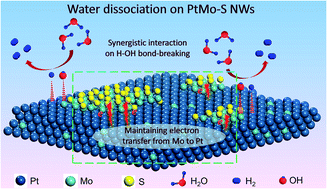
J. Mater. Chem. A, 2019,7, 24328-24336
https://doi.org/10.1039/C9TA09285D
Carbon fragments as highly active metal-free catalysts for the oxygen reduction reaction: a mechanistic study
Carbon fullerene fragments with low group-symmetry are highly active catalysts for the oxygen reduction reaction.
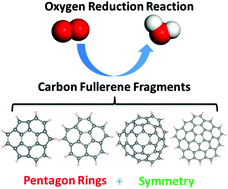
Nanoscale, 2019,11, 19422-19428
https://doi.org/10.1039/C9NR05338G
Selectivity for ethanol partial oxidation: the unique chemistry of single-atom alloy catalysts on Au, Ag, and Cu(111)
Doping of a strong-binding single-atom element into inert close-packed substrates leads to highly active and selective initial dehydrogenation at the α-C–H site of adsorbed ethanol.

J. Mater. Chem. A, 2019,7, 23868-23877
https://doi.org/10.1039/C9TA04572D
Bimetallic Pd96Fe4 nanodendrites embedded in graphitic carbon nanosheets as highly efficient anode electrocatalysts
Bimetallic Pd–Fe nanoalloys with tunable composition immobilized on graphitic carbon by one-pot radiolytic reduction show high electrocatalytic activity for alcohol oxidation.

Nanoscale Adv., 2019,1, 3929-3940
https://doi.org/10.1039/C9NA00317G
TiO2 photoanodes with exposed {0 1 0} facets grown by aerosol-assisted chemical vapor deposition of a titanium oxo/alkoxy cluster
TiO2 photoanodes with {0 1 0} facets exposed show high photoelectrochemical performance and IPCE of 100% at 350 nm.

J. Mater. Chem. A, 2019,7, 19161-19172
https://doi.org/10.1039/C9TA04482E
One-core-atom loss in a gold nanocluster promotes hydroamination reaction of alkynes
Au24 without a core atom exhibits higher activity in the intramolecular hydroamination of alkynes than Au25 with the core atom.
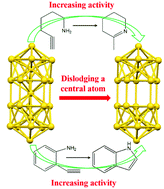
Nanoscale, 2019,11, 13767-13772
https://doi.org/10.1039/C9NR04219A
Single molybdenum center supported on N-doped black phosphorus as an efficient electrocatalyst for nitrogen fixation
Single Mo center supported on N-doped black phosphorus is predicted to be a compelling highly efficient and durable catalyst for electrochemical N2 fixation by density functional theory calculations.

Nanoscale, 2019,11, 13600-13611
https://doi.org/10.1039/C9NR02586C
N,P co-coordinated Fe species embedded in carbon hollow spheres for oxygen electrocatalysis
Carbon hollow spheres (FeNPC) with single-atomic and octahedral FeNxPy active sites are fabricated for oxygen electrocatalysis.

J. Mater. Chem. A, 2019,7, 14732-14742
https://doi.org/10.1039/C9TA03011E
A phenanthroline-based porous organic polymer for the iridium-catalyzed hydrogenation of carbon dioxide to formate
A novel phenanthroline-functionalized porous organic polymer (phen-POP) has been designed, and prepared for the first time without other reactive functional groups in the polymer skeleton. Post-synthetic metalation of phen-POP with IrCl3 afforded a single-site, highly active and selective catalyst for the hydrogenation of CO2 to formate.

J. Mater. Chem. A, 2019,7, 14019-14026
https://doi.org/10.1039/C9TA03807H
Unraveling the high-activity nature of Fe–N–C electrocatalysts for the oxygen reduction reaction: the extraordinary synergy between Fe–N4 and Fe4N
Fe4N can play a decisive role in boosting the catalytic performance of Fe–N4 coordination sites.

J. Mater. Chem. A, 2019,7, 11792-11801
https://doi.org/10.1039/C9TA02338K
Achieving highly efficient CO2 to CO electroreduction exceeding 300 mA cm−2 with single-atom nickel electrocatalysts
A high CO2 to CO electroreduction rate exceeding 300 mA cm−2 was achieved with single atom nickel and nitrogen doped three-dimensional porous carbon electrocatalysts.

J. Mater. Chem. A, 2019,7, 10651-10661
https://doi.org/10.1039/C9TA02405K
In situ incorporation of cobalt nanoclusters and nitrogen into the carbon matrix: a bifunctional catalyst for the oxygen depolarized cathode and chlorine evolution in HCl electrolysis
The co-insertion of both cobalt and nitrogen into the carbon matrix was achieved from single precursor without any templates. The obtained Co-NSC catalyst was explored bifunctionally towards both oxygen depolarized cathode and chlorine evolution under HCl electrolysis conditions.
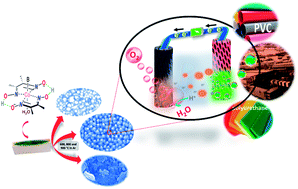
J. Mater. Chem. A, 2019,7, 10019-10029
https://doi.org/10.1039/C9TA00675C
Synergetic effects of strain engineering and substrate defects on generating highly efficient single-atom catalysts for CO oxidation
Developing highly efficient single-atom catalysts (SACs) containing isolated metal atom monomers dispersed on appropriate substrates has surged to the forefront of heterogeneous catalysis in recent years.
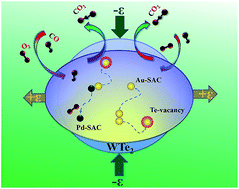
J. Mater. Chem. A, 2019,7, 9297-9304
https://doi.org/10.1039/C9TA01326A
Atmosphere-dependent stability and mobility of catalytic Pt single atoms and clusters on γ-Al2O3
Pt single atoms, stable on alumina under O2, form mobile clusters under H2, due to adsorbate- and nuclearity-dependent metal-support interaction.
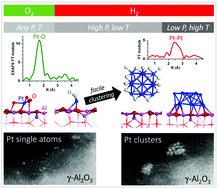
Nanoscale, 2019,11, 6897-6904
https://doi.org/10.1039/C9NR01641D
A heterogeneous single Cu catalyst of Cu atoms confined in the spinel lattice of MgAl2O4 with good catalytic activity and stability for NO reduction by CO
A heterogeneous single Cu catalyst exhibits good catalytic activity and durability at high temperature for NO reduction by CO due to the confinement effect of spinel lattice.

J. Mater. Chem. A, 2019,7, 7202-7212
https://doi.org/10.1039/C8TA11528A
g-C3N4 promoted MOF derived hollow carbon nanopolyhedra doped with high density/fraction of single Fe atoms as an ultra-high performance non-precious catalyst towards acidic ORR and PEM fuel cells
Atomic Fe-doped hollow carbon nanopolyhedra as efficient ORR catalysts.

J. Mater. Chem. A, 2019,7, 5020-5030
https://doi.org/10.1039/C8TA11785C
Conversion of dinitrogen to ammonia on Ru atoms supported on boron sheets: a DFT study
By first-principles computations, nitrogen becomes activated via distal pathway on the single Ru-atom-embedded two boron monolayers, exhibiting relatively low reaction energy barriers of 0.42 and 0.44 eV, respectively.
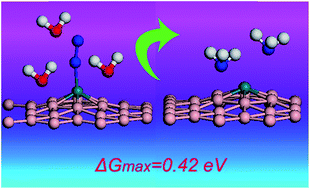
J. Mater. Chem. A, 2019,7, 4771-4776
https://doi.org/10.1039/C8TA08219G
Electrochemical reduction of CO2 by single atom catalyst TM–TCNQ monolayers
Eight novel two-dimensional TM–TCNQ (TM = V–Zn) monolayers as highly efficient and selective electrocatalysts for CO2 reduction have been systematically studied and the underlying detailed reaction mechanisms have been revealed.

J. Mater. Chem. A, 2019,7, 3805-3814
https://doi.org/10.1039/C8TA08677J
Cobalt single-atoms anchored on porphyrinic triazine-based frameworks as bifunctional electrocatalysts for oxygen reduction and hydrogen evolution reactions
Cobalt single atoms anchored on porphyrinic triazine frameworks exhibit high activity in ORR and HER.

J. Mater. Chem. A, 2019,7, 1252-1259
https://doi.org/10.1039/C8TA09490J
Two-dimensional π-conjugated metal–organic nanosheets as single-atom catalysts for the hydrogen evolution reaction
Two-dimensional planar metal–organic nanosheets exhibit a superior performance to Pt-based catalysts for hydrogen evolution reaction.

Nanoscale, 2019,11, 454-458
https://doi.org/10.1039/C8NR05900D
Single atom alloy catalyst for SO3 decomposition: enhancement of platinum catalyst's performance by Ag atom embedding
Single Ag atom embedded Pt particle as novel catalyst for SO3 decomposition. They show lower activation barrier and have potential towards better thermal resistance and better recyclability.

Nanoscale, 2018,10, 20599-20610
https://doi.org/10.1039/C8NR05179H
Unravelling the electrochemical mechanisms for nitrogen fixation on single transition metal atoms embedded in defective graphitic carbon nitride
Single transition metal atoms supported by defective g-C3N4 are examined by DFT for electrochemical N2 fixation. The single Ti atom is the most promising candidate for its high activity and stability owing to the coordination number of the  active center.
active center.

J. Mater. Chem. A, 2018,6, 21941-21948
https://doi.org/10.1039/C8TA06497K
A Co–N4 moiety embedded into graphene as an efficient single-atom-catalyst for NO electrochemical reduction: a computational study
Co–N4-embedded graphene exhibits superior catalytic performance for NO electrochemical reduction with a lower onset potential than that of Pt-based catalyst.

J. Mater. Chem. A, 2018,6, 7547-7556
https://doi.org/10.1039/C8TA00875B
Synergistic effect of an atomically dual-metal doped catalyst for highly efficient oxygen evolution
Isolated dual transition metal atoms (Ni and Fe) were uniformly embedded into graphitic carbon nitride via a metal–Nx bond, resulting in highly efficient catalytic activity due to the electronic structure reconfiguration.

J. Mater. Chem. A, 2018,6, 6840-6846
https://doi.org/10.1039/C8TA00550H
A stable rhodium single-site catalyst encapsulated within dendritic mesoporous nanochannels
A stable single-site Rh catalyst was formed inside individual channels of three-dimensional dendritic mesoporous silica nanospheres through aminosilane binding. The catalyst demonstrated an excellent activity, stability and recyclability in the reduction of 4-nitrophenol, high regioselectivity in the hydrosilylation of terminal alkyne.

Nanoscale, 2018,10, 1047-1055
https://doi.org/10.1039/C7NR06258C
Tailoring the framework composition of carbon nitride to improve the catalytic efficiency of the stabilised palladium atoms
The C/N ratio of the carbon nitride lattice is tailored by doping with carbon to assess the impact on the stabilisation of palladium atoms and their catalytic efficiency in the selective hydrogenation of 2-methyl-3-butyn-2-ol.

J. Mater. Chem. A, 2017,5, 16393-16403
https://doi.org/10.1039/C7TA04607C
About this collection
Guest Edited by;
Zhiqun Lin, Georgia Institute of Technology USA, Journal of Materials Chemistry A Associate Editor.
Federico Rosei, Institut National de la Recherche Scientifique Canada, Journal of Materials Chemistry C Associate Editor.
Shouheng Sun, Brown University USA, Nanoscale/Nanoscale Advances Associate Editor.
Xiao Cheng Zeng, University of Nebraska-Lincoln USA, Nanoscale/Nanoscale Advances Associate Editor.
This themed collection is the sixth in a series celebrating the International Year of the Periodic Table. ‘Single Atoms as Active Catalysts’ features papers from across the Materials and Nano journal portfolio; Materials Horizons, Nanoscale Horizons, Nanoscale, and Journal of Materials Chemistry A. The papers selected for this themed issue focus on the current hot trends in the single atom and nanocluster catalyst field, including synthetic strategies for high metal loadings, large-scale production, MOF-based single-atom catalysts, and more